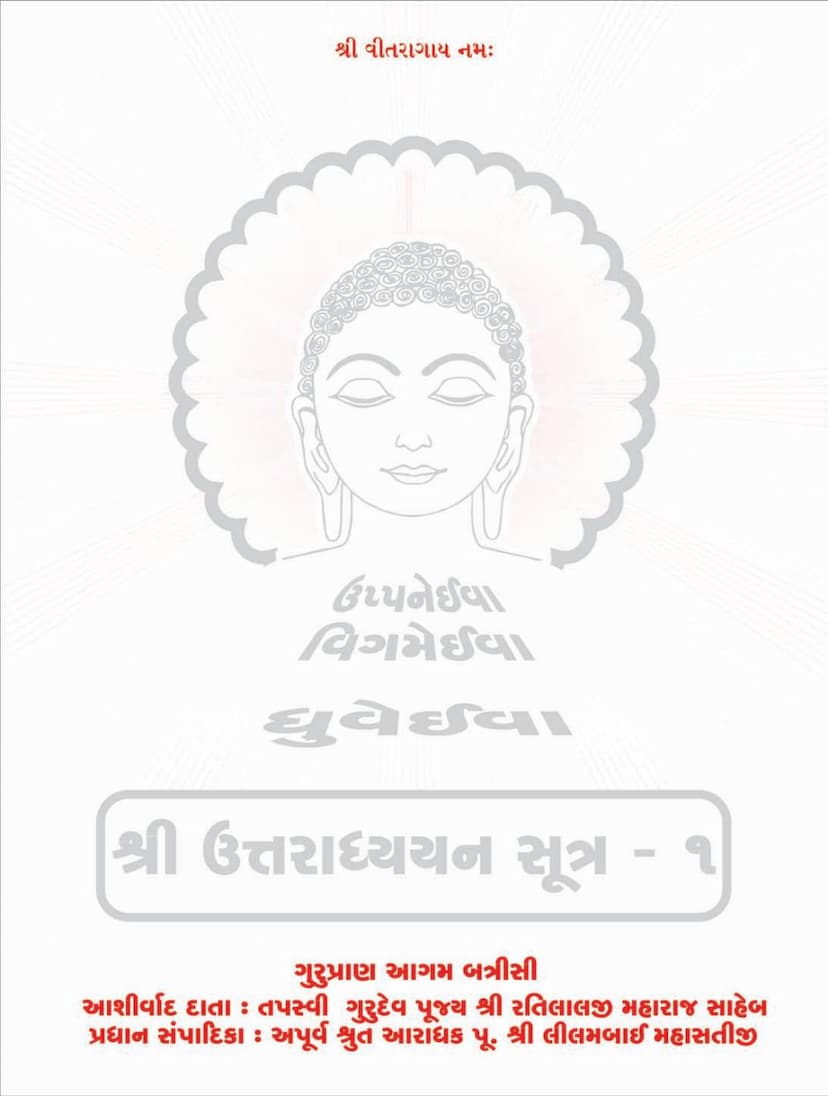Agam 30 Mool 03 Uttaradhyayana Sutra Part 01 Sthanakvasi
Added to library: September 1, 2025

Summary
The provided text is the first part of the Uttaradhyayana Sutra, volume 30 of the Agam 30 Mool series, published by Guru Pran Prakashan, Mumbai. It is a Jain text translated and compiled by Amitabai Mahasati, Aarti Bai Mahasati, and Subodhikabai Mahasati. The publication is dedicated to the memory of Pu. Shri Pranalalji M. Sa. and Pu. Shri Ratilalji M. Sa. and is part of the "Guru Pran Agam Batrisi" series.
This volume, Part 1 of the Uttaradhyayana Sutra, covers chapters 1 to 20 of the original text. It includes the original Sanskrit text (Mool Path), its Gujarati translation (Bhavarth), commentary (Vivechan), and appendices. The work is blessed by various esteemed Munis and Acharyas of the Gondal Gachh tradition, including Pu. Shri Jayant Muni M. Sa., Pu. Shri Girishchandraji M. Sa., and Pu. Shri Janak Muni M. Sa.
The text emphasizes the importance of studying the Agams, which contain the pure teachings of Lord Mahavir. It highlights that wealth is temporary and cannot protect one from the consequences of karma. The Uttaradhyayana Sutra, in particular, is presented as a spiritual guide that helps individuals understand the true nature of reality, detachment from worldly possessions, and the path to spiritual liberation.
The compilation process involved the dedicated efforts of several Mahasatijis who translated and compiled the text, making these profound teachings accessible to a wider audience. The publisher, Guru Pran Prakashan, is committed to making these ancient Jain scriptures available, honoring the legacy of their gurus. The catalog link provided is jainqq.org, which likely hosts Jain literature.
The initial pages include dedications, blessings from spiritual leaders, and acknowledgments of supporters, highlighting the collaborative and devotional nature of this publication. The text also contains lists of various Jain Agams and their translators, indicating the extensive scope of the "Guru Pran Agam Batrisi" project. The initial pages also provide contact information for acquiring these books.
The content of the Uttaradhyayana Sutra itself, as presented in this volume, covers various aspects of Jain philosophy and ethics, including:
- Vinay Sutra (Chapter 1): Discusses the importance of humility and respect in spiritual progress, contrasting virtuous and non-virtuous disciples. It emphasizes the significance of adhering to the guru's teachings and conduct.
- Parishah Chapter (Chapter 2): Details the 22 types of hardships (Parishah) that ascetics may encounter and the importance of enduring them with equanimity, highlighting their role in karma destruction and spiritual purification.
- Chaturangi Chapter (Chapter 3): Explores the rarity of human birth and the four essential factors for spiritual progress: human life, hearing the true Dharma, faith in Dharma, and exerting effort in spiritual practice.
- Asanskrut Chapter (Chapter 4): Discusses the transient nature of life, the futility of attachment to worldly things, and the importance of self-discipline and vigilance, contrasting the unpreparedness of the ignorant with the wisdom of the mindful.
- Akama Marani Chapter (Chapter 5): Differentiates between 'Akama Maran' (involuntary death without spiritual preparation) and 'Sakama Maran' (voluntary, spiritually prepared death), stressing the importance of the latter for spiritual progress.
The later chapters (6-20) delve into various ethical principles, narratives illustrating Jain teachings, and guidance for ascetics. For instance, the text mentions chapters dealing with:
- Kshullak Nigranthiya (Chapter 6): Likely discusses basic principles for ascetics.
- Urbhiya (Chapter 7): Potentially discusses the consequences of attachment and delusion, possibly through a narrative.
- Kapiliya (Chapter 8): May contain teachings on detachment, particularly illustrated by the story of Kapila.
- Nami Pravarjya (Chapter 9): Narrates the story of King Nami's renunciation and spiritual quest, highlighting the importance of detachment.
- Drumpatraka (Chapter 10): Likely uses the analogy of a falling leaf to illustrate the impermanence of life and the need for constant vigilance.
- Bahusruta Puja (Chapter 11): Focuses on the reverence and importance of scholars and those who have mastered the scriptures (Bahusruta).
- Harikeshiya (Chapter 12): Features the story of Muni Harikeshi, who was born in a low caste but achieved spiritual heights through his conduct and devotion, demonstrating the irrelevance of birth in spiritual attainment.
- Chitta Sambutiya (Chapter 13): Discusses the cycle of birth and death, possibly through the narrative of Chitta and Sambhuta, and the consequences of karma.
- Ishukariya (Chapter 14): Tells the story of King Ishukari, who encountered various spiritual seekers and learned profound lessons.
- Sabhasiksha (Chapter 15): Likely deals with the conduct and characteristics of a true mendicant (Bhikkhu).
- Brahmacharya Samadhisthana (Chapter 16): Focuses on the ten states of concentration and discipline for practicing celibacy (Brahmacharya).
- Papa Shramana (Chapter 17): Likely discusses the pitfalls of spiritual practice and what constitutes a 'sinful' or erroneous ascetic.
- Sanjaya (Chapter 18): Narrates the story of King Samjaya, who achieved spiritual enlightenment.
- Mrigaputra (Chapter 19): Tells the story of Mrigaputra, illustrating the teachings through his life experiences.
- Mahanigranthiya (Chapter 20): Discusses the principles of the liberated soul (Nigrantha) and the path to ultimate liberation.
The text strongly advocates for adherence to Jain principles, such as non-violence, truthfulness, non-stealing, celibacy, and non-possession, and emphasizes the role of detachment and spiritual discipline in achieving liberation. It highlights the rarity of human birth and the preciousness of life for spiritual attainment.